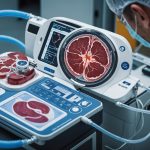Overview of Non-Invasive Cancer Screening Innovations
Non-invasive cancer screening represents a monumental stride in health technology, spearheading efforts in early detection and significantly impacting patient outcomes. Defined as monitoring methods that do not require surgical or intrusive intervention, they enhance patient comfort while providing critical insights into cancer presence or progression. The importance of these innovations lies not only in their ability to detect cancer at an early stage but also in their potential to save lives by improving prognosis and reducing mortality rates.
Recent trends in cancer detection technologies underline the urgent need for effective non-invasive methods. Liquid biopsies, advanced imaging techniques, and breath analysis stand out as promising advancements. Each of these technologies operates through different mechanisms to capture vital biological information without harming the patient. Liquid biopsies, for instance, analyze circulating tumor DNA, while imaging techniques leverage artificial intelligence for more targeted diagnostics.
Have you seen this : Discover Cutting-Edge Pain Relief Strategies for Rheumatoid Arthritis Patients
The impact of these breakthroughs on early diagnosis is profound. By facilitating detection at a stage when treatment options are most effective, non-invasive techniques improve the overall quality of care. They empower healthcare professionals to make informed decisions swiftly, thus enhancing therapy outcomes and patient satisfaction. These innovations are undoubtedly reshaping modern oncology, promising a more compassionate and effective approach to cancer management.
Latest Technologies in Non-Invasive Screening
Innovative cancer screening technologies are revolutionising healthcare with pioneering breakthroughs in biomarker research and imaging techniques.
Topic to read : Exploring Cutting-Edge Innovations in Stem Cell Therapy for Heart Tissue Regeneration
Liquid Biopsy Techniques
Liquid biopsies represent a significant leap forward. They analyse various body fluids such as blood to detect circulating tumor DNA and other markers. There are different types, including those focusing on genetic mutations and protein presence. This method is minimally invasive, offering quicker and potentially more comprehensive insights. Notable case studies demonstrate its capability in identifying cancers like lung and colorectal with impressive precision.
Advanced Imaging Modalities
Recent advancements in imaging modalities, specifically MRI and ultrasound, utilise state-of-the-art technology. Machines now integrate artificial intelligence to enhance image clarity, enabling earlier and more accurate cancer detection. These innovations have shown particular promise in detecting cancers such as breast and prostate in preliminary studies, translating to improved patient outcomes.
Breath Analysis Methods
Breath analysis involves detecting volatile organic compounds unique to cancer. Initial clinical trials and research outcomes suggest its potential for widespread use due to its simplicity and non-invasive nature. This technology could significantly improve accessibility to cancer screening, making it a feasible option for broader populations.
Research Studies and Clinical Trials
In the evolving landscape of cancer research, clinical trials play a pivotal role in validating the efficacy of non-invasive cancer screening methods. These studies are critical for assessing how new technologies perform in real-world settings, offering insights into their practical applications. One key focus is on trials that document the successes of liquid biopsies, which have demonstrated impressive accuracy in detecting early-stage cancers by analysing circulating tumour DNA.
For instance, a landmark study highlighted their capability in identifying mutations linked to specific cancers with high precision. Similarly, numerous clinical trials have explored advanced imaging modalities where artificial intelligence significantly enhances diagnostic capabilities, particularly in crucial areas like breast and prostate cancers.
Patient feedback from these studies often underscores an improved experience due to the minimally invasive nature of these methods. Moreover, the impact on early detection rates cannot be overstated, with many trials showing non-invasiveness correlating positively with higher patient compliance and detection accuracy.
Looking forward, ongoing and future studies are expected to refine these technologies further, ensuring they continue to provide robust solutions in screening efficacy. This emphasis on research is crucial to not only validate but also expand the scope of non-invasive screening technologies in contemporary healthcare.
Expert Opinions and Perspectives
Non-invasive cancer screening continues to spark interest and debate among oncology experts. Their medical opinions are paramount in understanding the efficacy and integration of these technologies into regular practice. Through insightful interviews, leading oncologists reflect on the transformative impact of these healthcare insights. They emphasize how non-invasive methods are enhancing early diagnosis, paving the way for more personalized and patient-friendly strategies.
Interviews with Leading Oncologists
Experts highlight the effectiveness of innovative technologies, particularly in detecting cancers earlier than traditional methods. They note the seamless integration of liquid biopsies and imaging techniques into routine diagnostics, thereby improving patient outcomes due to their non-invasive nature. Yet, challenges persist; healthcare providers often grapple with adapting to these rapid technological changes, underscoring the necessity for ongoing education and training.
Perspectives from Researchers
Researchers address the limitations and potential inherent in current methodologies. They foresee upcoming innovations that promise to address existing gaps and hurdles. Such developments are expected to significantly impact screening efficacy. Observing fruitful collaborations between technology innovators and the medical community, there is optimism about future medical breakthroughs. However, sustained research funding remains crucial to realize these visions and further refine non-invasive cancer screening.
Future Prospects and Innovations in Oncology
In the realm of oncology, the future holds promising prospects as non-invasive technologies advance rapidly, paving the way for more personalised and effective cancer screening methods. Predictions indicate that the future of cancer screening is heavily reliant on technological advancements which will enhance precision, accessibility, and efficiency across healthcare systems. Emerging trends emphasize integrating personalized medicine, tailoring healthcare to individual genetic profiles, thereby rising as a crucial component of early detection strategies.
Technological advancements are expected to address the limitations of current methodologies, offering more accurate and less intrusive options. The ongoing integration of artificial intelligence (AI) into diagnostic procedures exemplifies this trend, demonstrating the potential to significantly bolster the depth and speed of analyses.
Continuous funding and research underpin these innovations, enabling breakthroughs that expand the capabilities of non-invasive cancer screening. Future investments are crucial in overcoming existing challenges and unlocking novel solutions, ensuring sustained progress in healthcare innovations.
The importance of sustained research cannot be overstated, enabling the translation of cutting-edge developments into practical applications within clinical settings. With continued advancements, non-invasive methods not only promise efficiency but also embody a shift towards a more humane and effective approach to cancer management.
Benefits and Challenges of Non-Invasive Methods
In the realm of non-invasive cancer screening, patients gain significant benefits, notably reduced risk and discomfort. Unlike traditional methods, these innovations mitigate physical stress, offering a more comfortable experience. This ease enhances patient compliance and willingness to undergo regular screenings, crucial for early cancer detection.
Non-invasive methods bring noteworthy economic implications for healthcare systems and insurance providers. Although initial adoption can be costly, the long-term benefits often outweigh expenses. Early detection leads to reduced treatment costs and better resource allocation. Lower healthcare expenses reflect on insurance policies, but widespread integration requires overcoming financial hurdles.
Challenges persist in the validation and acceptance of these methods among clinicians. Acceptance hinges on extensive evidence supporting their reliability and screening efficacy. Many healthcare professionals demand rigorous trials to compare new technologies against established screenings. Achieving consensus is vital for mainstream application.
Lastly, the rapid evolution of health technology presents hurdles in keeping practitioners updated. Continuous education and training are imperative to harness the full potential of non-invasive innovations. Addressing these challenges ensures that healthcare systems can effectively incorporate these groundbreaking methods, ultimately enhancing patient outcomes and care experiences.
Comparisons to Traditional Cancer Screening Methods
In the realm of cancer detection, the emergence of non-invasive cancer screening presents a significant shift from traditional methods. Notably, these methods offer enhanced patient experiences by minimizing discomfort. Traditional approaches often require invasive procedures that can be painful and daunting. In contrast, non-invasive methods boast higher patient acceptance due to their less intrusive nature.
Strengths of Non-Invasive over Traditional Methods
Non-invasive techniques are celebrated for providing improved accuracy and quicker results in the crucial stage of early detection. Tools like liquid biopsies and advanced imaging technologies often showcase superior diagnostic precision compared to their traditional counterparts. Certain case examples, such as liquid biopsies in detecting lung cancer, highlight situations where non-invasive methods have outperformed traditional screenings in effectiveness.
Limitations of Non-Invasive Approaches
Despite their strengths, non-invasive methods may falter in some scenarios. Traditional screenings, like mammograms, remain the gold standard for specific cancer types due to their established reliability. In such cases, traditional methods hold an advantage, leading to the possibility of hybrid approaches. These strategies can benefit from combining the strengths of both non-invasive and traditional methods, potentially offering a comprehensive solution for cancer detection.











